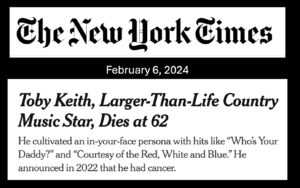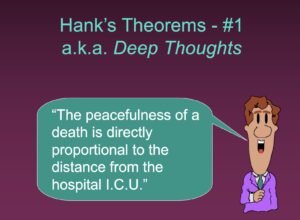“I quit chemo…and it probably did more damage to me than the cancer did….” This was Toby Keith’s feelings about chemotherapy, according to his friend Brett Favre.
So, is the takeaway to never do chemo? Absolutely NOT.

Photo by Hiroshi Tsubono on Unsplash
Country singer Toby Keith was diagnosed with stomach cancer in 2021. About six months later, he announced to his fans on social media that he was receiving chemotherapy, radiation, and surgery.
“So far, so good,” Mr. Keith wrote in a June 2022 statement on multiple social media platforms. “I need time to breathe, recover, and relax. I am looking forward to spending this time with my family. But I will see the fans sooner than later. I can’t wait.”

Keith’s last concert in Las Vegas, (TobyKeith.com)
Indeed, he got back out there and played a series of shows in Las Vegas less than two months prior to his death a few weeks ago. In an interview right before he died, he said, “Cancer is a roller coaster. You just sit here and wait on it to go away — it may not ever go away.”
“[Keith] handled it with grace and faith and family and stood up to the cancer as good as you can,” said the former Green Bay Packers quarterback. “[But] I think in the end he was just tired,” Favre added.
We can hardly base treatment decisions on one man’s experience. Mr. Keith, diagnosed at age 60, made his decision based on the type of cancer he had and his own unique goals of care at that stage in the disease.
 I am guessing if, during that last phone call, Favre asked, “Do you regret getting the chemo?” Keith might have responded, “Not at all.” Perhaps it bought him some time. Maybe, earlier in the treatment, he did not think it was causing “more damage… than the cancer.”
I am guessing if, during that last phone call, Favre asked, “Do you regret getting the chemo?” Keith might have responded, “Not at all.” Perhaps it bought him some time. Maybe, earlier in the treatment, he did not think it was causing “more damage… than the cancer.”
In my years as a hospice chaplain, I got to see patients after they had stopped treatments that were meant to cure the disease. Heck, you can’t get into hospice unless you stop curative treatments. Many expressed similar sentiments as Toby Keith. In medical-speak, “the burdens outweighed the benefits.” There, perhaps, was a time when the benefits were greater, but no more.
Or, to paraphrase Ecclesiastes in the Hebrew Bible, “There is a time for chemo and a time for no chemo.”
Let go and let be.
_____________________
Author Chaplain Hank Dunn, MDiv, has sold over 4 million copies of his books Hard Choices for Loving Peopleand Light in the Shadows (also available on Amazon).


 About that same time, I started traveling around the country making presentations to healthcare professionals. My most popular talk, “Helping Patients and Families with End-of-Life Decisions,” includes a series of slides with “Hank’s Theorems” on various end-of-life issues. The first slide says, “The peacefulness of a death is directly proportional to the distance from the hospital ICU.”
About that same time, I started traveling around the country making presentations to healthcare professionals. My most popular talk, “Helping Patients and Families with End-of-Life Decisions,” includes a series of slides with “Hank’s Theorems” on various end-of-life issues. The first slide says, “The peacefulness of a death is directly proportional to the distance from the hospital ICU.”
